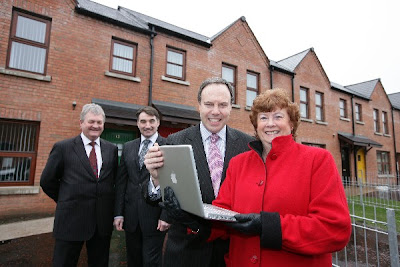
The last of a series of posts looking at the results in this year’s Ofcom Nations & Regions Communications Market Report for Northern Ireland.
In general, broadband availability is highest in urban areas. And the highest speeds will be achieved by the more densely populated built-up areas where people live a lot closer to their exchange than in rural populations.
Yet broadband take-up is highest in Northern Ireland’s rural communities! Could that be the long dark evenings with only the village pub open for entertainment. (I stereotype ridiculously.) Could it be that fewer folk in rural areas have access to high speed internet as part of their day jobs, so have to rely on it at home? (Though rural commuters are pretty common.) Or as mobile networks become slower and less reliable the further away you go from the densely populated urban areas, does mobile internet become less appealing, leaving broadband the only option?
Belfast has a particularly low broadband penetration, in line with Ofcom’s “small towns”, but markedly lower than Derry.
With an average age of 35, Northern Ireland has the lowest aged regional population in the UK after London (34). As expressed in a previous post about mobile, the hypothesis is that Derry has the youngest population in NI, taking full advantage of gadgets and gizmos, which may explain some of the differences between the Derry and Belfast figures.

So no surprise that 34% of those surveyed in Derry had used the internet to watch TV or video content, compared to just 21% in Belfast.
(Though for online radio listening, Belfast (10%) is pretty much level with Derry (9%) – perhaps reflecting the fact that dialup/mobile is good enough for radio, and it’s also been around longer online.)
And if Derry is characterised by being young, perhaps Belfast’s low broadband uptake is due to a higher number of people living in rented or short-term accommodation, unwilling to take out lengthy rentals or unable to install equipment. Does Belfast have a significantly more temporary population that Derry? More migrant workers in Belfast? More students? (Though they’d be the very people to push for cable or DSL to be installed in a house.)
Ofcom’s raw figures show that use of wireless hubs is more popular than average in Northern Ireland (53%) with peaks in the rural east (58%) and border areas (56%). Hot spots (made choice of term) in Swansea, Yorkshire, Newcastle upon Tyne and the rural east/south east of England can top the NI peak.
Northern Ireland (19%) has a higher than average (17%) use of mobile phones to listen to audio content (such as radio, MP3s or podcasts). Again, Derry technorati shine out at 23%, though behind the audiophiles in Liverpool (25%) and Birmingham (27%).
And we’re far behind Scotland when it comes to our media stacking habits and multi-tasking while using the internet.

Back to broadband ...
Northern Ireland trumpeted its 100% broadband availability ahead of anywhere else in the UK. On the ground this translates into 360,000 broadband connections, of which 680 are satellite. Virgin Media pass by the door of 30% of NI households.
The Ofcom report also highlights a couple of Fibre trials in NI. In conjunction with the Department of Enterprise, Trade and Investment (DETI), Virgin Media is installing 20Meg broadband to 70+ houses in Lavinia Square, a social housing development near the Ormeau Road in Belfast, using Fibre To The Cabinet/Kerb technology. And up the street, Bytel are supplying Fibre To The Home into another ten houses – capable of 100Meg, but limited to 20Meg for the trial.

A further 43 homes will be connected as part of the second phase by October. And a formal project evaluation is due by the end of the year. DETI is funding the project to the tune of £67k to install the infrastructure. However, much of the £33k cost that was poured into the ground used to dig the trenches in which to lay the fibre optic cable could be avoided if the developers planned this in to their foundations!
No comments:
Post a Comment